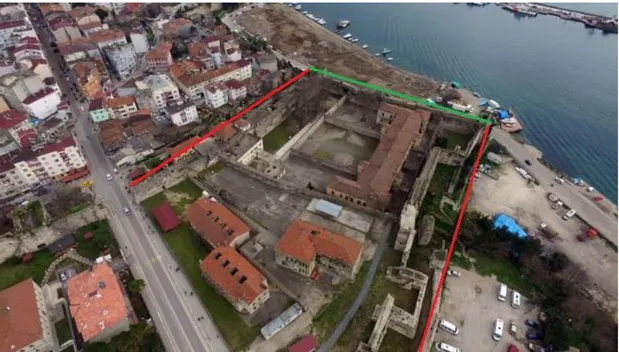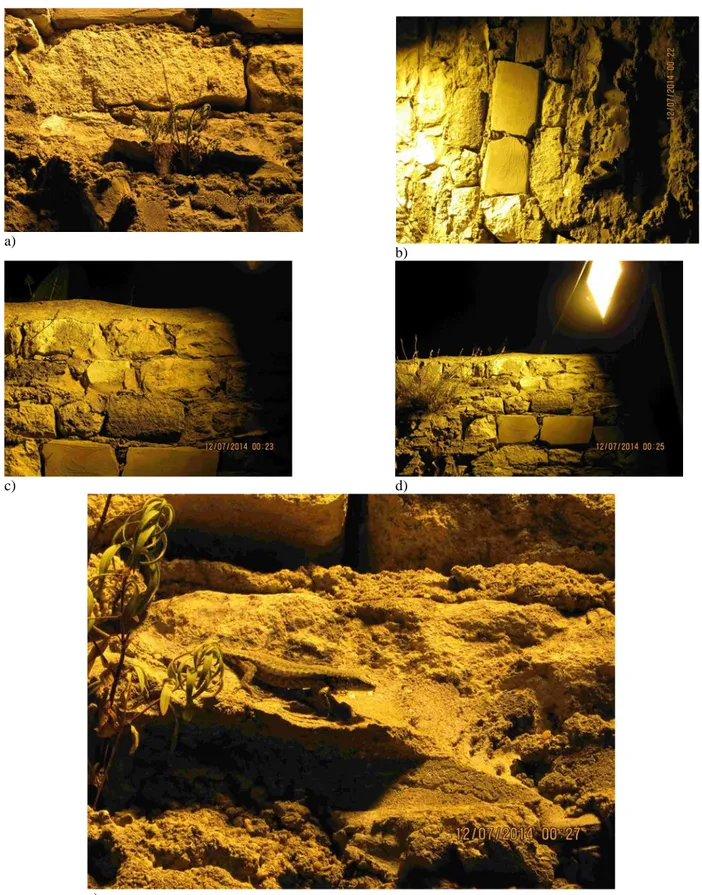Data on nocturnal activity of Darevskia rudis (Bedriaga, 1886) (Sauria:
Lacertidae) in Central Black Sea Region, Turkey
MURAT AFSAR1*, MEHMET KURSAT SAHIN2,3, BIRGÜL AFSAR1, KERIM ÇIÇEK4*, CEMAL VAROL TOK5
1
Department of Biology, Faculty of Science and Letters, Manisa Celal Bayar University, Manisa, Turkey
2Zoology Section, Department of Biology, Hacettepe University, Ankara, 06800 Turkey
3Department of Biology, Kamil Özdağ Faculty of Science, Karamanoglu Mehmetbey University, Karaman, Turkey 4Zoology Section, Department of Biology, Faculty of Science, Izmir, Ege University, Turkey
5Department of Biology, Faculty of Science and Letters, Çanakkale Onsekiz Mart University, Canakkale, Turkey
*Correspondence: E-mail: kerim.cicek@ege.edu.tr
Received 18 October 2018 │ Accepted by V. Pešić: 7 December 2018 │ Published online 12 December 2018.
Abstract
Interactions between the environment and internal regulation drive the biophysiological dynamics of lizards. Although diurnal lizards are usually heliothermic, they can sometimes be active in the absence of sunlight. Here, we report, for the first time, a case of nocturnal behavior (aided by the artificial light) in the spiny-tailed lizard - Darevskia rudis (Bedriaga, 1886) – a species that normally exhibits diurnal activity.
Key words: Reptilia; spiny-tailed lizard; Anatolia; behavior; artificial light.
Introduction
Interactions between the internal rhythms and the environment shape the activity patterns of lizards (Underwood 1992). Unlike geckos that exhibit crepuscular lifestyle, the Lacertid lizards are considered to be strictly heliothermic and therefore are thought to be only active during the day. A range of behaviours of these ectotherms, including locomotion, feeding and reproduction, depend on environmental conditions, (Angilletta et al. 2004; Meiri et al. 2013). Ambient temperature is an important factor determining these processed (Pontes-da Silva et al. 2018). Thus, any change in these conditions may cause unusual behaviors.
Some studies have shown that diurnal lizards stick to their circadian rhythms and any major modifications in their biophysiological dynamics can only be observed under the laboratory conditions (Molina-Borja et al. 1986; Bertolucci et al. 1999). Therefore, detecting any modified activity patterns in lizard’s natural habitats is important. Several reports in the literature have documented nocturnal activity in primarily diurnal reptiles: Desert tortoises [(Gopherus agazzi), Iguanids (Gambelia wislizenii): Huey (1982), Phrynosomatids (Sceloporus clarkii): Martinez-Mendez et al. (2013), and the Horned lizards Phrynosoma
platyrhinos: Harris (1958), Phrynosoma cornutum: Williams (1959), Phrynosoma modestum: Lara-Resendiz et al. (2013), and Phrynosoma asio: Raya-Garcia (2014). A few such observations have also been recorded
for the Lacertid lizards [(Timon lepidus: Valverde (1967); Gallotia sp.: Böhme et al. (1985), Podarcis
their behavioural strategies in-situ conditions without any experimental artificial manipulations. Interestingly, other studies show that diurnal lizards are persistent in their circadian rhythms while they are examined under artificial light sources in laboratory conditions (Molina-Borja et al. 1986; Bertolucci et al. 1999). Here, we report a first case of nocturnal activity of a diurnal Lacertid species in Anatolia.
Material and Methods
Individuals were observed during herpetological surveys in July and August 2014. First observation was recorded on the 12th July 2014 at 00:20 a.m. We observed two male and two female Spiny-tailed lizard,
Darevskia rudis, active and foraging at night on the walls of the Historical Sinop Prison, Turkey (36T
677448 E, 4654818 N; 15 m asl). The air temperature was 25ºC, recorded by AccuWeather Superior Accuracy™ on the first night. Since that time, this activity pattern was recorded continuously until the end of August 2014. The ambient air temperatures varied in a narrow range (mean temperature: 26.4 ºC) during these night surveys. The walls were illuminated by the powerful long-range field scanning projectors (approximately 1000W each). The walls were built from ashlar blocks (in the 13th century) and were covered with infrequent grassy vegetation. Under these conditions, the 2x250 (red lines) and 1x150 (green line) meter transects along the prison walls were set up in the east-west direction, and surveyed by at least three observers (Figure 1).
Figure 1: Transect lines along the Sinop historical prison walls.
Results & Discussion
The mean number of active lizards per a single night observation period was 14.5 (min 12, max 17 in different nights). Both adult and juvenile individuals were observed displaying the following major behaviors: leaving the shelter (a), active movement (b), foraging (c), fronting to artificial light source (d) and feeding (e) (Figure 2 a-e).
Darevskia rudis is often found in urbanized areas (Sevgili et al. 2016). Previous studies
demonstrated strong correlation between the lizards’ body and the ambient temperatures, as well as capability of altering their metabolic processes or energy assimilation levels (Nowakowski et al. 2018).
Avoidance of very high daytime temperatures, generation of heat from the light projectors and attraction of insects towards the projectors might be the reasons for a switch from the diurnal towards nocturnal activity in these lizards. The stone wall can reach an extreme temperature of up to 46ºC in the daytime. We speculate that it may be a major driving force underlying the alteration in behavior. Secondly,
although the lizards’ body temperatures have not been recorded, the powerful projector can serve as an external heat source for keeping their body temperature in thermal safety margins (TSM) and so allowing mobility. Moreover, nocturnal behavior might help to avoid predation more easily, by escaping to the non-illuminated parts of the wall. Finally, the projectors attract insects, providing foraging opportunities (Perry et
al. 2008).
a)
b)
c) d)
e)
Figure 2: The major nocturnal activities of Darevskia rudis. (a: leaving the shelter, b: mobility in its habitat, c:
Anatolia has been well studied under many herpetological surveys (Baran et al. 1992; Tok & Çiçek 2014; Afsar et al. 2016; Kumlutaş et al. 2017). Although most of them are related to faunistic records, phylogeography or similar issues, there was a recent interest in studying the unusual behavioural strategies in reptiles (Kurnaz et al. 2016; Koç et al. 2018). Thus, our findings will add to the studies of biophysiological dynamics in the Lacertid lizards:
This nocturnal activity strategy of a diurnal lizard has been observed in-situ in the absence of any manipulation by the observers. A combination of temperature and other above mentioned factors might cause such unusual behavior (Vidan et al. 2017). This is the first documentation of the nocturnal activity in D.
rudis. The artificial light in urban zone created a new specific ecological niche, exploited by D. rudis.
Further research that will address an in-situ thermal comparison of obligate diurnal and this nocturnal population might be a good point to understand the thermal alterations in D. rudis. More generally, it would make a valuable contribution to understand the activity patterns of Eurasian poikilothermic organisms.
Acknowledgements
We thank to General Directorate of Nature Protection and National Parks, Sinop Branch for permission and to Turunç Peyzaj A.Ş. which financially supported the study
References
Afsar, M., Çiçek, K., Tayhan, Y. & Tok, C.V. (2016) New records of Eurasian Blind Snake, Xerotyphlops
vermicularis (Merrem, 1820) from the Black Sea region of Turkey and its updated distribution. Biharean Biologist, 10 (2), 98-103.
Angilletta, M.J., Steury, T.D. & Sears, M.W. (2004) Temperature, growth rate, and body size in ectotherms: Fitting pieces of a life- history puzzle. Integrative and Comparative Biology, 44, 498–509.
Baran, İ., Yılmaz, İ., Kete, R., Kumlutaş, Y. & Durmuş, H. (1992) Batı ve Orta Karadeniz Bölgesinin Herpetofaunası. Turkish Journal of Zoology, 16, 275 – 288 (in Turkish).
Bertolucci, C., Leorati, M., Innocenti, A. & Foà, A. (1999) Circannual variations of lizard circadian activity rhythms in constant darkness. Behavioral Ecology and Sociobiology, 46, 200-209.
Böhme, W., Hutterer, R. & Bings, W. (1985) Die Stimme der lacertidae, spe- ziell der kanareneidechsen (Reptilia: Sauria). Bonner zoologische Beiträge, 36, 337-354.
Carretero, M.A., Sillero, N., Lazić, M. M. & Crnobrnja-Isailović, J. (2012) Nocturnal activity in a Serbian population of Podarcis muralis (Laurenti, 1768). Herpetozoa, 25, 87-89.
Harris, R. W. (1958) A nocturnal tendency in Phrynosoma platyrhinos. Copeia, 222-222.
Huey, R. B. (1982) Temperature, physiology and the ecology of reptiles. in Gans, C. & Crews, D., eds.
Biology of the Reptilia. Vol. 12. Academic Press, London, pp. 25–92.
Koç, H., Bülbül, U. & Kutrup, B. (2018) Is the Spiny-tailed Lizard Darevskia rudis (Bedriaga, 1886) Active All Year?. Ecologia Balkanica, 10, 47-51.
Kumlutaş, Y., Ilgaz, C. & Yakar, O. (2017) Herpetofauna of Karabük Province. Acta Biologica Turcica, 30 (4), 102-107.
Kurnaz, M., Kutrup, B. & Bülbül, U. (2016) An Exceptional Activity for Darevskia derjugini (Nikolsky, 1898) From Turkey. Ecologia Balkanica, 8, 91-93.
Lara-Resendiz, R.A., Jezkova, T., Rosen, P.C. & Méndez-De La Cruz, F.R. (2014) Thermoregulation during the summer season in the Goode’s Horned Lizard Phrynosoma goodei (Iguania: Phrynosomatidae) in Sonoran Desert. Amphibia-Reptilia, 35, 161–172.
Martínez-Méndez, N., Lara Resendiz, R.A. & Blair, C. (2013) Sceloporus clarkii (Clark’s Spiny Lizard) Nocturnal foraging activity. Herpetological Review, 44, 148-148.
Meiri, S., Bauer, A.M., Chirio, L., Colli, G.R., Das, I., Doan, T.M., Feldman, A., Herrera, F., Novosolov, M., Pafilis, P., Pincheira-Donoso, D., Powney, G., Torres-Carvajal, O., Uetz, P., Van Damme, R. (2013) Are lizards feeling the heat? A tale of ecology and evolution under two temperatures. Global
Ecology and Biogeography, 22, 834–845.
and ultradian fluctuations in the activity of the lizard Gallotia galloti (Sauria - Lacertidae).
Biological Rhythm Research, 17(4), 295-305.
Nowakowski, A. J., Watling, J. I., Thompson, M. E., Brusch IV, G. A., Catenazzi, A., Whitfield, S. M., Kurz, D. J., Suarez-Mayorga, A., Aponte-Gutierrez, A., Donnelly, M. A. & Todd, B. D. (2018). Thermal biology mediates responses of amphibians and reptiles to habitat modification. Ecology
letters, 21(3), 345-355.
Perry, G., Buchanan, B.W., Fisher, R.N., Salmon, M. & Wise, S.E. (2008) Effects of artificial night lighting on amphibians and reptiles in urban environments. in: Mitchell, J.C.; Jung- Brown, R.E. & Bartholomew, B. (Eds.): Herpetological Conservation vol. 3. Salt lake city (Society for the Study of amphibians and reptiles) pp. 239-256.
Pontes-da-Silva, E., Magnusson, W. E., Sinervo, B., Caetano, G. H., Miles, D. B., Colli, G. R., Diele-Viegas, L. M., Fenker, J., Santos, J. C. & Werneck, F. P. (2018). Extinction risks forced by climatic change and intraspecific variation in the thermal physiology of a tropical lizard. Journal of Thermal Biology, 73, 50-60.
Raya-Garcia, E. (2014) Phrynosoma asio (Giant Horned Lizard) Crepuscular and nocturnal activity.
Herpetological Review, 45, 330-330
Sevgili, H., Karataş, A. & Candan, O. (2016) Biodiversity in Urban environments of Ordu City and Nearby Areas: Mammals, Birds, Reptiles and Amphibians. Hacettepe Journal of Biology and Chemistry, 44 (1), 47–63.
Tok, C.V. & Çiçek, K. (2014) Amphibians and reptiles in the Province of Çanakkale (Marmara Region, Turkey) (Amphibia; Reptilia). Herpetozoa, 27 (1/2), 65-76.
Underwood, H. (1992) Endogenous rhythms, in: Gans, C. & Crews, D. (Eds.): Hormones, brain, and behavior. Physiology E. Biology of the reptilia vol. 18, University of Chicago Press, pp. 229- 297. Valverde, J.A. (1967) Estructura de una comunidad de vertebrados terrestres. Monografías de la Estación
Biológica de Doñana, 1, 1-218.
Vidan, E., Roll, U., Bauer, A., Grismer, L., Guo, P., Maza, E., Novosolov, M., Sindaco, R., Wagner, P., Belmaker, J. & Meiri, S. (2017) The Eurasian hot nightlife—Environmental forces associated with nocturnality in lizards. Global Ecology and Biogeography, 26, 1316–1325. https://doi.org/10.1111/geb.12643
Williams, K.L. (1959) Nocturnal activity of some species of horned lizards, genus Phrynosoma.

